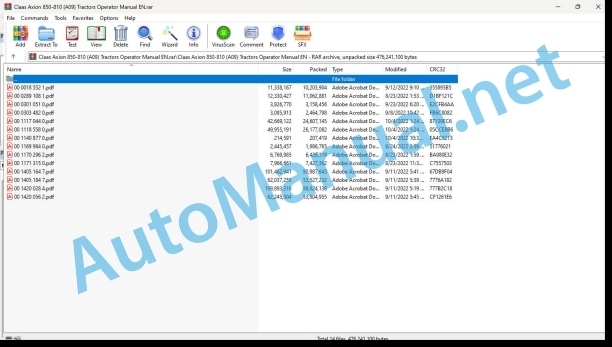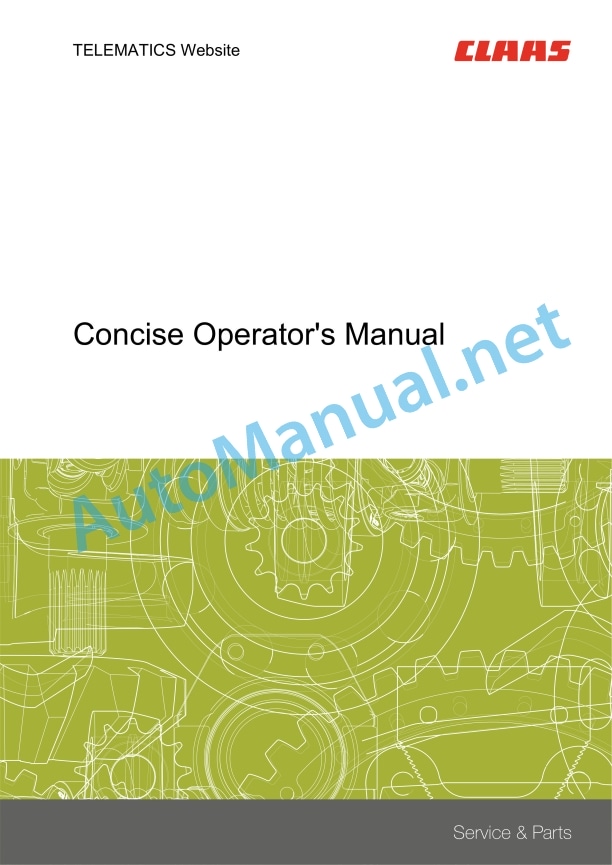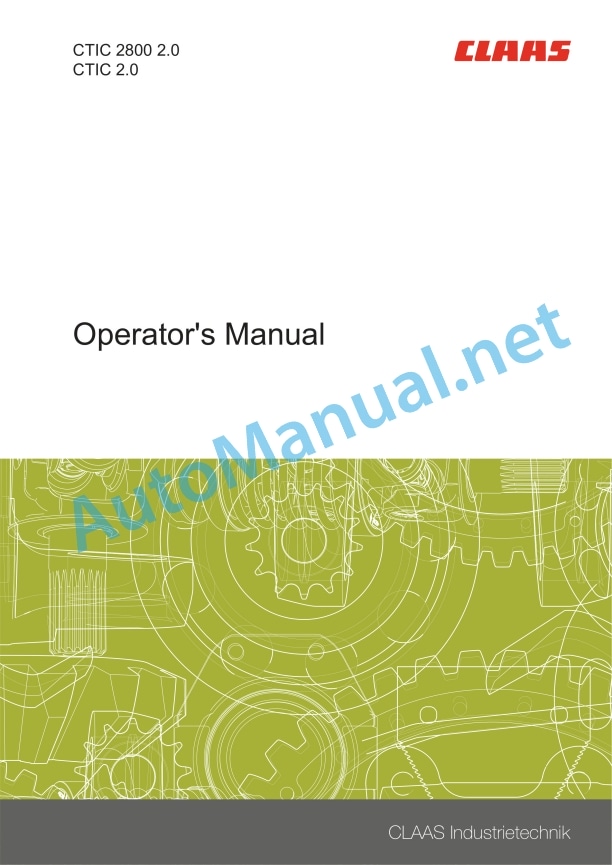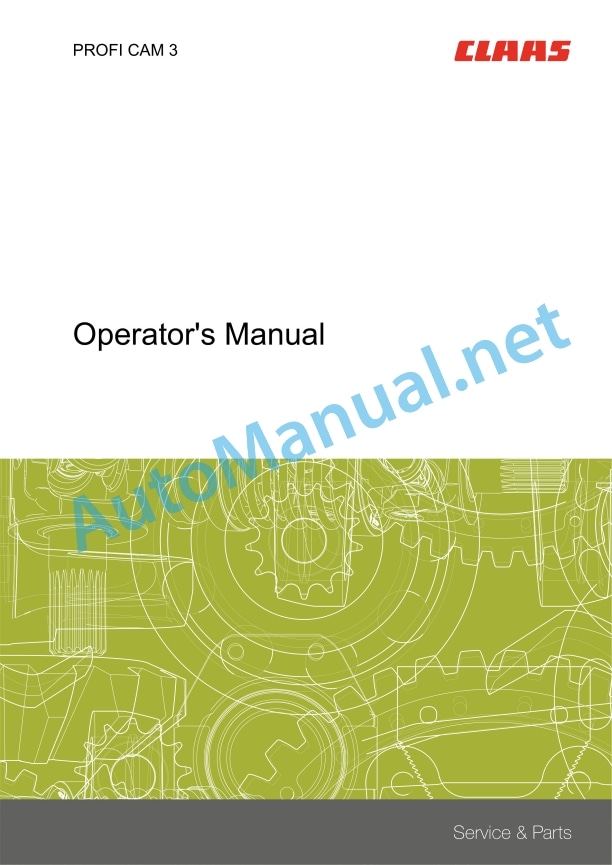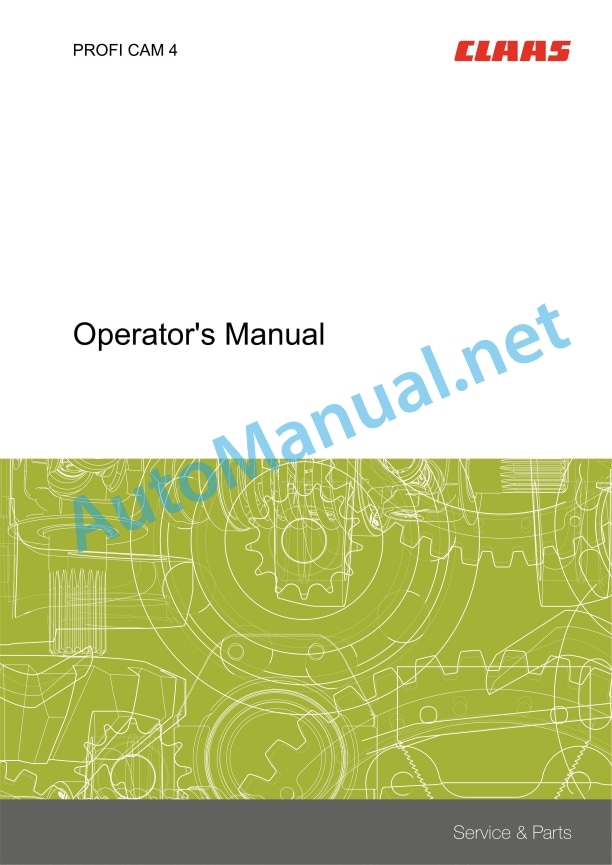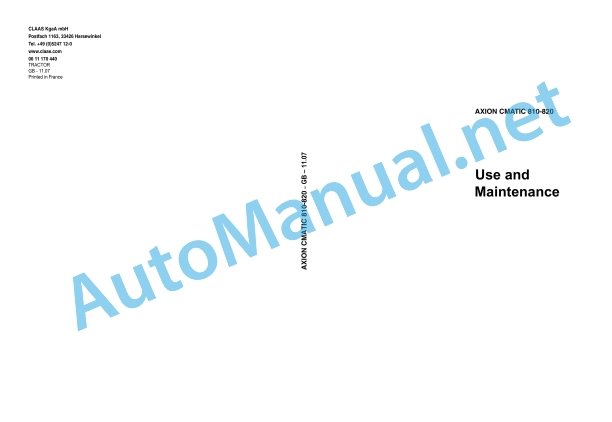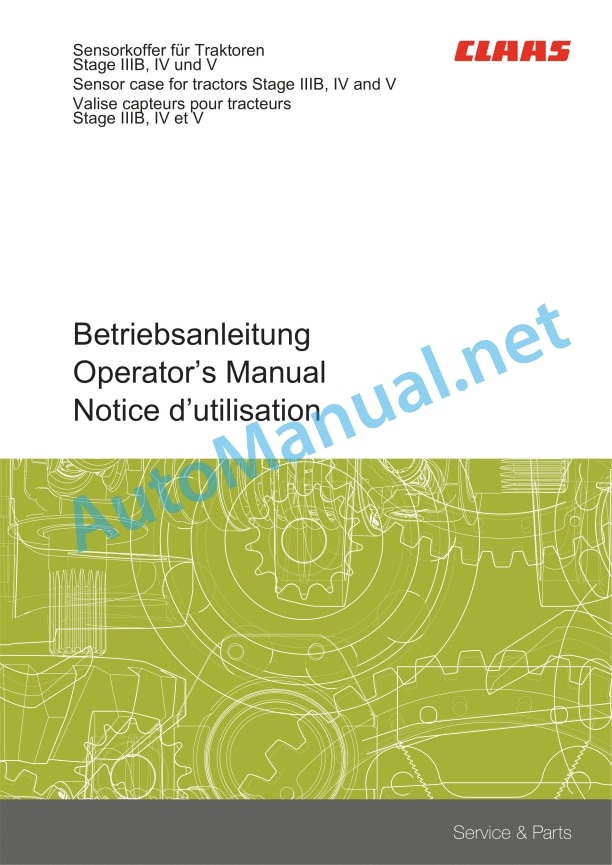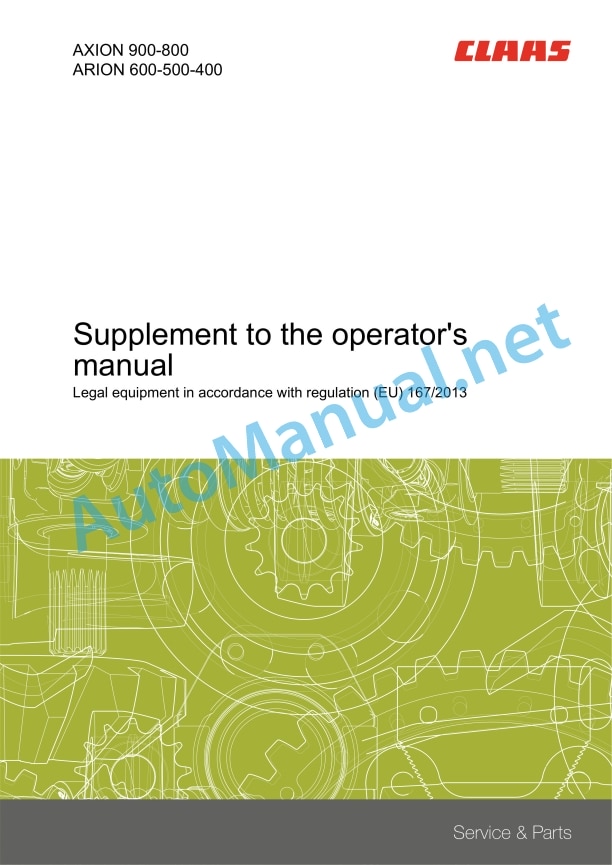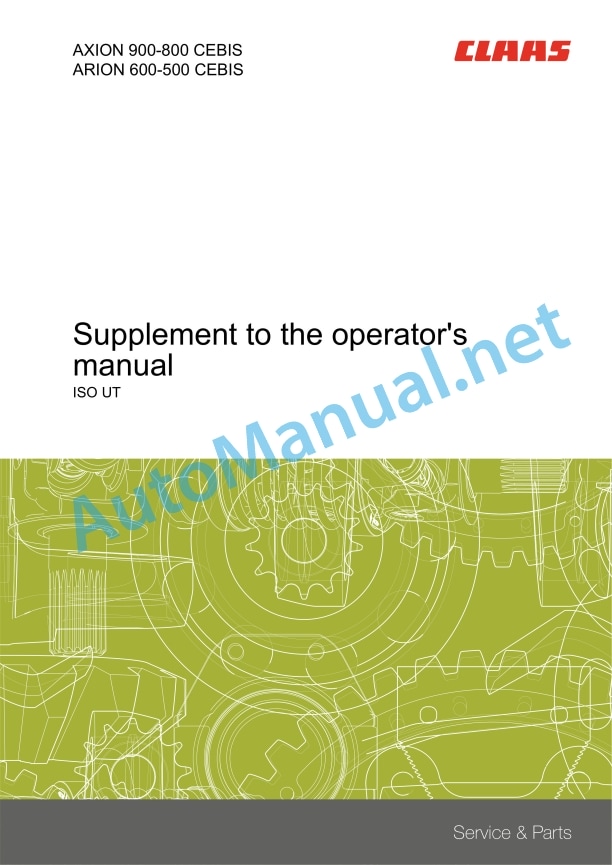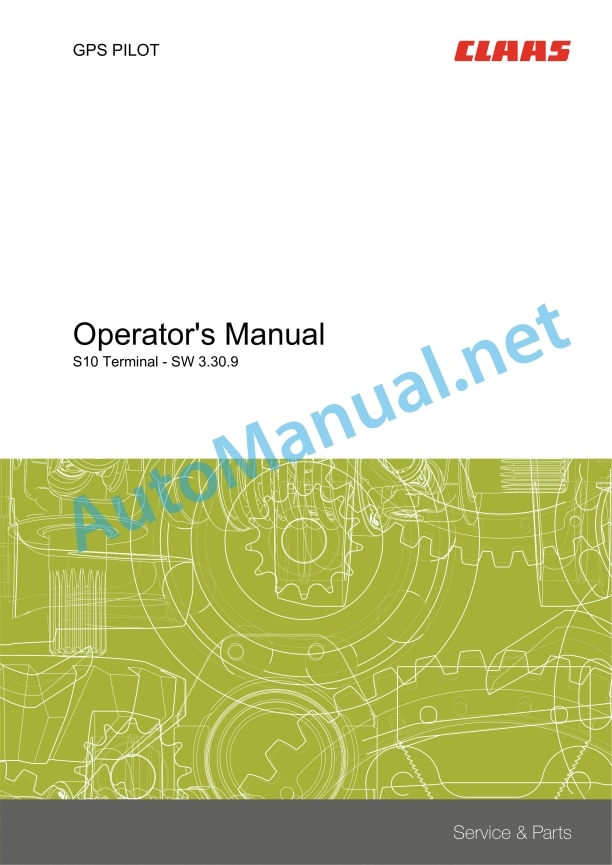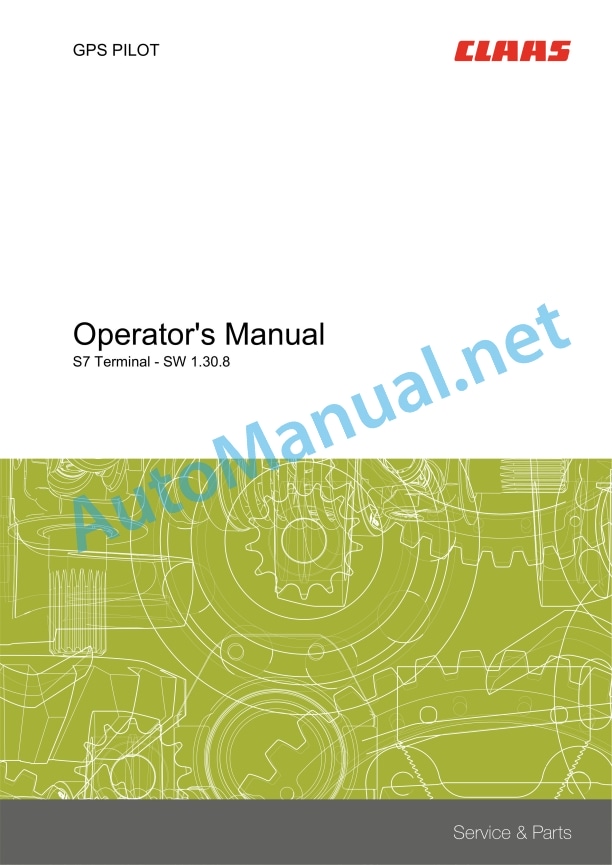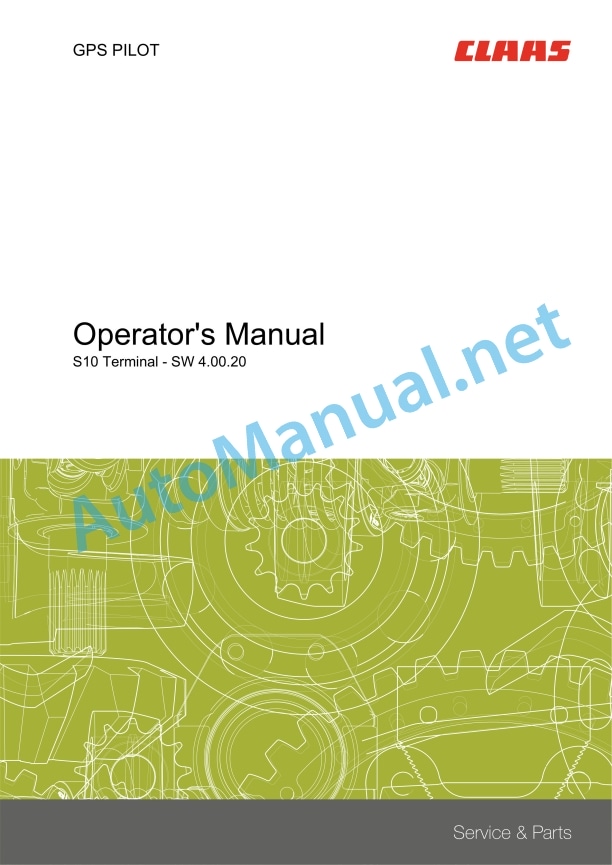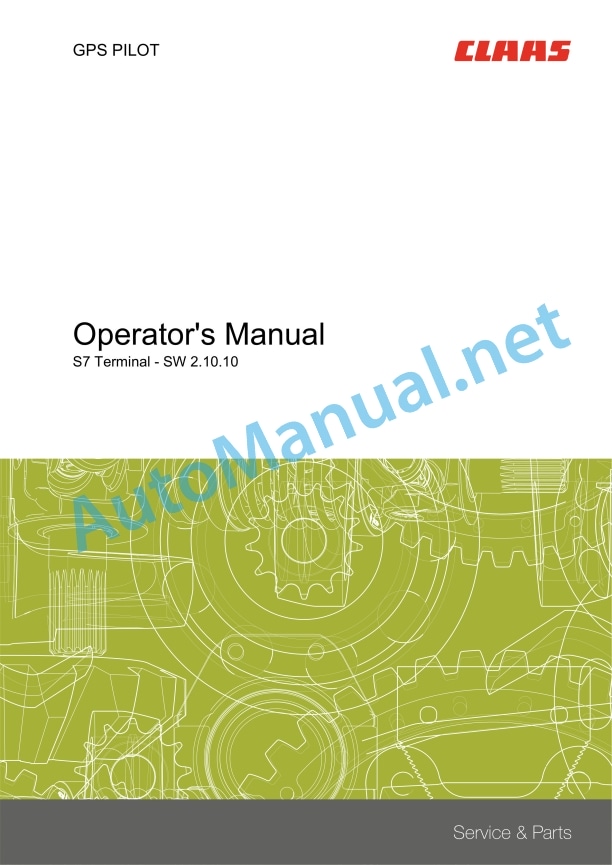Claas Axion 850-810 (A09) Tractors Operator Manual EN
$50.00
- Model: Axion 850-810 (A09) Tractors
- Type Of Manual: Operator Manual
- Language: EN
- Format: PDF(s)
- Size: 373 MB
File List:
00 0018 552 1.pdf
00 0289 108 1.pdf
00 0301 051 0.pdf
00 0303 482 0.pdf
00 1117 044 0.pdf
00 1118 558 0.pdf
00 1140 877 0.pdf
00 1169 984 0.pdf
00 1170 296 2.pdf
00 1171 315 0.pdf
00 1405 164 7.pdf
00 1405 184 7.pdf
00 1420 028 4.pdf
00 1420 056 2.pdf
00 0018 552 1.pdf:
TELEMATICS Website
Table of contents
1 About this Concise Operator’s Manual
1.1 Notes on the manual
1.1.1 Validity of manual
1.1.2 Notes regarding the Concise Operator’s Manual
1.1.3 Notes on warranty
2 Safety
2.1 Intended use
2.1.1 Proper use
3 Product description
3.1 Overview and method of operation
3.1.1 TELEMATICS product variants
3.1.2 TONI (TELEMATICS on implements)
3.1.3 Fleet View
3.1.4 TELEMATICS basic
3.1.5 TELEMATICS advanced
3.1.6 TELEMATICS professional
3.1.7 TELEMATICS app
4 Operating and control elements
4.1 TELEMATICS overview
4.1.1 Illustration conventions of buttons and navigation elements
4.1.2 Symbols and colours
4.2 Menu structure
4.2.1 Start screen
4.2.2 TELEMATICS website site map
4.2.3 Main menu overview
4.2.4
4.2.5
4.2.6
00 0289 108 1.pdf:
CTIC 2800 2.0CTIC 2.0
Table of contents
1 Introduction
1.1 General information
1.1.1 Validity of manual
1.1.2 Information about this Operator’s Manual
1.1.3 Symbols and notes
1.1.4 Optional equipment
1.1.5 Maintenance information
1.1.6 Warranty information
1.1.7 Qualified specialist workshop
1.1.8 Spare parts and technical questions
1.2 Intended use
1.2.1 Intended use
1.2.2 Reasonably foreseeable misuse
2 Safety
2.1 Identifying warnings
2.1.1 Hazard signs
2.1.2 Signal word
2.2 Safety rules
2.2.1 Importance of Operator’s Manual
2.2.2 Optional equipment and spare parts
2.2.3 Danger due to damage to the tyre pressure control system
2.2.4 Technical condition
2.2.5 Complying with technical limit values
2.2.6 Keeping protective devices functional
2.2.7 Personal protective equipment
2.2.8 Dangers when driving on the road and on the field
2.2.9 Environmental protection and disposal
2.2.10 Noise can damage your health
2.2.11 Pressurised fluids
2.2.12 Compressed air
2.2.13 Hot surfaces
2.2.14 Maintenance work and repair work
2.2.15 Welding work prohibited
3 Product description
3.1 Package list
3.1.1 Delivery state
3.2 Overview and method of operation
3.2.1 Tyre pressure control system
3.2.2 Tyre pressure control system
3.3 Safety devices
3.3.1 Mechanical and electronic safety features
Pressure limitation
System behaviour when an air line is torn off
Manual operation
3.4 Identification plates and identification numbers
3.4.1 Identification plate of tyre pressure control system
4 Operating and display elements
4.1 Monitor
4.1.1 Overview of operating screen
4.2
4.2.1
4.2.2
4.3
4.3.1
4.3.2
4.3.3
4.3.4
4.4
4.4.1
5 Technical specifications
5.1 Tyre pressure control system
5.1.1 Properties
5.1.2 Lubricants
6 Handling
6.1 Transport and storage
6.1.1 Transport
Compressor
6.1.2 Storage
7 Preparing the product
7.1 Putting into operation
7.1.1 Carry out prior to operation
Installing the tyre pressure control system
Workplace description
8 Operation
8.1 Tyre pressure control system
8.1.1 Observe prior to operating the system
8.1.2 Parking position
Removing the rotary transmission leadthrough cover
Removing the rotary transmission leadthrough cover
Moving the hose packages of front wheels to the parking position
Moving the hose package of the rear right wheel to the parking position
Moving the hose package of the rear left wheel to the parking position
Installing the cover on the rotary transmission leadthrough
Installing the cover on the rotary transmission leadthrough
Removing the rotary transmission leadthroughs
8.1.3 Parking position
Removing the rotary transmission leadthrough cover
Removing the rotary transmission leadthrough cover
Moving the hose packages of front wheels to the parking position
Moving the hose package of the rear right wheel to the parking position
Moving the hose package of the rear left wheel to the parking position
Installing the cover on the rotary transmission leadthrough
Installing the cover on the rotary transmission leadthrough
Removing the rotary transmission leadthroughs
8.1.4 Working position
Installing the rotary couplings
Moving the hose packages of front wheels to the working position
Moving the hose package of the rear right wheel to the working position
Moving the hose package of the rear left wheel to the working position
Installing the cover on the rotary transmission leadthrough
Installing the cover on the rotary transmission leadthrough
8.1.5 Working position
Installing the rotary couplings
Moving the hose packages of front wheels to the working position
Moving the hose package of the rear right wheel to the working position
Moving the hose package of the rear left wheel to the working position
Installing the cover on the rotary transmission leadthrough
Installing the cover on the rotary transmission leadthrough
8.1.6 Determining the wheel loads
Fundamentals for determining wheel loads
Determining the wheel load on the front axle
Determining the wheel load on the rear axle
Determining the wheel load of the hitched implement
Example of how to calculate the wheel loads
8.1.7 Activating the tyre pressure control system
8.1.8 Deactivating the tyre pressure control system
8.1.9 Creating a profile
Entering the profile name
Setting the tyre pressure values for the towing vehicle
Enabling the trailer
Trailer priority circuit
Setting the tyre pressure values for the trailer
Selecting the tyre size
8.1.10 Changing the profile
8.1.11 Deleting the profile
8.1.12 Activating the profile
Operating the profile in
Changing set values in
Operating the profile in
9 Faults and remedies
9.1 Tyre pressure control system
9.1.1 Overview of possible problems with the tyre pressure control system
10 Maintenance
10.1 Maintenance interval overview
10.1.1 Operating hours
10.1.2 Every 10 operating hours or daily
10.1.3 Every 600 operating hours
10.1.4 Every 1200 operating hours or annually
10.1.5 Maintenance work every 2400 operating hours
10.2 Tyre pressure control system
10.2.1 Cleaning and preserving the tyre pressure control system
10.2.2 Checking and cleaning the compressor air filter
Checking the air filter
Cleaning the air filter
10.2.3 Changing the air filter element
10.2.4 Cap
Removing
Installing
10.2.5 Checking the compressor oil level
10.2.6 Checking the compressor oil level
10.2.7 Changing the compressor oil and oil filter
Changing the oil filter
Topping up oil
10.2.8 Replacing the compressor oil separator
11 Putting out of operation and disposal
11.1 General information
11.1.1 Putting out of operation and disposal
00 0301 051 0.pdf:
PROFI CAM 3
Table of contents
1 Introduction
1.1 Notes on the manual
1.1.1 Validity of manual
1.1.2 Information about this Operator’s Manual
1.1.3 Symbols and notes
1.1.4 Optional equipment
1.1.5 Qualified specialist workshop
1.1.6 Maintenance information
1.1.7 Warranty notes
1.1.8 Spare parts and technical questions
1.2 Intended use
1.2.1 Intended use
1.2.2 Reasonably foreseeable misuse
2 Safety
2.1 Identifying warnings
2.1.1 Hazard signs
2.1.2 Signal word
2.2 Safety rules
2.2.1 Meaning of Operator’s Manual
2.2.2 Observing safety decals and warnings
2.2.3 Optional equipment and spare parts
3 Product description
3.1 Overview and method of operation
3.1.1 How the PROFI CAM works
3.2 Identification plates and identification number
3.2.1 Position of identification plates
3.2.2 Explanation of PROFI CAM identification plate
3.3 Information on the product
3.3.1 CE marking
4 Operating and control elements
4.1 Camera system
4.1.1 Camera system monitor
4.2 Menu structure
4.2.1 Main menu
4.2.2
4.2.3
4.2.4
4.2.5
4.2.6
5 Technical specifications
5.1 PROFI CAM
5.1.1 Monitor
5.1.2 Camera
5.1.3 Switch box
5.1.4 Degree of protection against foreign bodies and water
6 Preparing the product
6.1 Shutting down and securing the machine
6.1.1 Switching off and securing the machine
6.2 Prior to operation
6.2.1 Carry out prior to operation
6.2.2 Installing the sun protection
6.2.3 Aligning the camera
6.2.4 Connecting the camera electrics
7 Operation
7.1 Monitor
7.1.1 Switching on the monitor
7.1.2 Calling up the menu
7.1.3 Setting a menu item
7.1.4 Setting the image orientation
7.1.5 Setting automatic screen darkening
7.1.6 Image mirroring
7.1.7 Setting the trigger view
7.1.8 Setting the follow-up time for trigger view
7.1.9 Setting the display mode
7.1.10 Activating/deactivating a display mode
8 Faults and remedies
8.1 Electrical and electronic system
8.1.1 Overview of problems on PROFI CAM camera system
8.1.2 Replacing the switch box fuse
9 Maintenance
9.1 Maintenance intervals
9.1.1 Every 10 operating hours or daily
9.2 Camera system
9.2.1 Checking the camera system for dirt
9.2.2 Cleaning the camera
9.2.3 Cleaning the switch box
9.2.4 Cleaning the monitor
10 Placing out of operation and disposal
10.1 General Information
10.1.1 Putting out of operation and disposal
11 Technical terms and abbreviations
11.1 Abbreviations
11.1.1 Units
11.1.2 Abbreviations
11.1.3 Technical terms
00 0303 482 0.pdf:
PROFI CAM 4
Table of contents
1 Introduction
1.1 Notes on the manual
1.1.1 Validity of manual
1.1.2 Information about this Operator’s Manual
1.1.3 Symbols and notes
1.1.4 Optional equipment
1.1.5 Qualified specialist workshop
1.1.6 Maintenance information
1.1.7 Notes on warranty
1.1.8 Spare parts and technical questions
1.2 Intended use
1.2.1 Intended use
1.2.2 Reasonably foreseeable misuse
2 Safety
2.1 Identifying warnings
2.1.1 Hazard signs
2.1.2 Signal word
2.2 Safety rules
2.2.1 Meaning of Operator’s Manual
2.2.2 Structural changes
2.2.3 Optional equipment and spare parts
2.2.4 Operation only following proper putting into operation
2.2.5 Technical status
2.2.6 Respecting technical limit values
Respecting technical limit values
2.2.7 Hazards when driving on roads and fields
3 Product description
3.1 Overview and method of operation
3.1.1 How the PROFI CAM works
3.2 Identification plates and identification number
3.2.1 Identification plates
3.3 Information on the product
3.3.1 CE marking
4 Operating and display elements
4.1 Camera system
4.1.1 Camera system monitor
4.1.2 CEBIS
4.2 Menu structure
4.2.1 Main menu
4.2.2
4.2.3
4.2.4
4.2.5
4.2.6
5 Technical specifications
5.1 PROFI CAM
5.1.1 Monitor
5.1.2 Camera
5.1.3 Switch box
6 Preparing the product
6.1 Switching off and securing the machine
6.1.1 Switching off and securing the machine
6.2 Prior to putting into operation
6.2.1 Carry out prior to operation
6.2.2 Installing the sun protection
6.2.3 Aligning the camera
7 Operation
7.1 Monitor
7.1.1 Switching on the monitor
7.1.2 Calling up the menu
7.1.3 Setting a menu item
7.1.4 Setting the image orientation
7.1.5 Setting automatic screen darkening
7.1.6 Image mirroring
7.1.7 Setting the trigger view
7.1.8 Setting the follow-up time for trigger view
7.1.9 Setting the display mode
7.1.10 Activating/deactivating a display mode
8 Faults and remedies
8.1 Electric and electronic system
8.1.1 Overview of problems on PROFI CAM camera system
9 Maintenance
9.1 Maintenance intervals
9.1.1 Every 10 operating hours or daily
9.2 Camera system
9.2.1 Checking the camera system for dirt
9.2.2 Cleaning the camera
9.2.3 Cleaning the switch box
9.2.4 Cleaning the monitor
10 Putting out of operation and disposal
10.1 General information
10.1.1 Putting out of operation and disposal
11 Technical terms and abbreviations
11.1 Abbreviations
11.1.1 Units
11.1.2 Abbreviations
11.1.3 Technical terms
00 1117 044 0.pdf:
Recommendations
For your safety
Appropriate use
Description
DESCRIPTION: Chapter symbols
CHAPITRE_TDM_N3_CMATIC_TDM-04A.pdf
Identification A.2
Certification A.4
SAFETY A.5
Operating and working environment B.2
Lighting, indicators and safety B.6
Main switch (key operated) B.12
multifunction armrest B.13
Seat B.14
Steering wheel B.17
Instrument panel B.18
Display B.24
Natural ventilation and windows B.25
Heating – ventilation – manual air conditioning B.28
Heating/ventilation/automatic climate control B.29
Cab suspension B.33
Trailer/implement light socket C.2
Electric cabinet supply socket C.3
Event counter socket C.4
ISO socket C.5
Provision for the installation of a control casing in the cab C.6
Battery C.7
Battery master switch C.8
Fuses and relays C.9
Characteristics D.2
Displays D.3
SAFETY D.4
Engine control D.6
Fuel D.14
Transmission specifications E.2
Displays E.5
SAFETY E.8
Gearbox E.11
Rear axle E.32
Stationary working E.47
Towing E.48
Front axle F.2
Mechanical protection F.4
Front axle engagement F.5
Differential lock F.8
Proactiv suspension F.10
Hydraulic systems G.4
Linkage G.18
Hitch G.29
Front linkage H.2
Front power take-off H.3
Front linkage H.4
Front power take-off H.10
Cebis Panel I.2
Claas Sequence Management I.50
Tyres J.2
Track widths J.5
SPECIAL CASES J.26
Dimensions and weights K.2
Capacities K.4
Ballast K.5
General L.2
Frequency L.3
Bleeding air from the injection system L.34
Maintenance logbook L.35
OPERATIONS MANDATORY UNDER THE TERMS OF THE CONTRACTUAL GUARANTEE M.2
CHAPITRE_A_N3_CMATIC_04A.pdf
A – IDENTIFICATION – CERTIFICATION – SAFETY
Identification
Tractor plate
Engine plate
Certification
Safety instructions
FOREWORD
PRECAUTIONS BEFORE STARTING
CONDITION OF THE TRACTOR
ADJUSTMENT OR MAINTENANCE – REPAIRS
Use of axle stands
Hydraulics
Electrical services
Re-fuelling
ROAD USE – USE FOR TRANSPORT
OPERATION
GENERAL RULE
WHEEL TRACK
ATTACHING IMPLEMENTS
STATIONARY WORK
USE OF TOOLS DRIVEN BY THE PTO
TOXIC PRODUCTS
AIR CONDITIONING
SAFETY CABS
ENVIRONMENTAL SAFETY
Safety stickers with warning pictograms
Placing the gear box in neutral
Front linkage
Front tow hook
Use and Maintenance
SPEED LIMITS AND 13 YEAR AGE LIMIT FOR CHILDREN
Air conditioning
1 000 rpm PTO
External controls
PTO GUARD
HIGH PRESSURE CLEANING (air conditioning)
Accumulator
CHAPITRE_B_N3_CMATIC_04A.pdf
B – Driving position
Operating and working environment
Controls and instruments (operator station)
Description
Controls and instruments (Instrument panel)
Description
STOWAGE AND ACCESSORIES
Description
Lighting, indicators and safety
Description
CONTROLS
Driving lights and horn
Operation
Driving/indicator lights and horn
Working lights and rotating beacon
Operation
Overhead light
Operation
Rear view mirrors
Adjustment
Main switch (key operated)
Description
multifunction armrest
Adjustment
Operation
COMFORT SEAT
PNEUMATIC SEAT
PASSENGER SEAT
Steering wheel
Adjustment
Instrument panel
Description
Instrument panel transmission display
Alarm display
Operation
Primary alarms
Secondary alarms
Other alarms
Operation
Calibration
PROCEDURE
Cebis Panel
Description
Natural ventilation and windows
Operation
NATURAL VENTILATION
WINDSCREEN SUN BLIND
De-icing the rear window and electric rearview mirrors
Windscreen wash/wipe
Heating – ventilation – manual air conditioning
Description
Operation
Adjusting forced ventilation
Adjusting the air temperature
Cab isolation
Air conditioning
Heating/ventilation/automatic climate control
Description
Operation
Adjusting forced ventilation
Adjustment of forced air temperature
outside temperature display
Climate control mode
economy climate control mode
De-icing mode
Recirculation mode
changing from degrees Celsius to degrees fahrenheit
reinitialisation of the climate control unit
Cab suspension
Adjustment
CHAPITRE_C_N3_CMATIC_04A.pdf
C – Electrical system
Trailer/implement light socket
Description
Electric cabinet supply socket
Description
Event counter socket
Description
ISO socket
Description
PREFITMENTS FOR INSTALLING A CONTROL BOX IN THE CAB
Fitting box mounting
Operation
Cable routing
Operation
Description
Battery compartment
Battery master switch
Description
Fuses and relays
Recommendations
Cab-mounted services fuse box
Description
Relay allocation
Allocation of fuses
Cab top fuse box
Description
Relay allocation
Allocation of fuses
Primary services fuse box
Description
Relay allocation
Allocation of fuses
CHAPITRE_D_N3_CMATIC_04A.pdf
D -ENGINE
CHARACTERISTICS
Displays
Description
Instrument panel
Cebis Panel
Safety: Mechanical protection
Operation
Cebis Panel
Operation
Instrument panel
Operation
Recommendations
Running in
Operating temperature
Revolution speeds
Operating at intermediate power
Full power operation
Specific consumption
Engine control
Starting the engine
Operation
Operations before start
Starting the engine
Recommendations: COOLANT HEATER
Accelerator controls
Operation
Accelerator pedal
Operation
Hand accelerator
Operation
Engine rpm memory function
Operation
Adjustment: Cebis
Adjustment: Manual
Use the adjustment buttons on the arm rest
Direct adjustment of engine rpm memories
Stopping the engine
Operation
Claas power management
Operation
Recommendations
Quality requirement
Filling the tank
Handling the fuel
CHAPITRE_E_N3_CMATIC_04A.pdf
Transmission specifications
GEAR BOX
Rear axle
Characteristics
Power Take offs (PTO)
Characteristics
Displays
Cebis Panel
Operation
Road screen
Description
Work screen
Description
Reverser neutral
Operation
Operation
Driver’s seat safety
Transmission neutral
Operation
Operation
Mechanical protection
Operation
Instrument panel
Operation
Cebis Panel
Operation
Basic operation
Operation
Preliminary conditions
Move the tractor forward
Stop the tractor
Emergency stops
changing direction of motion
Immobilizing the tractor
Advanced driving
Operation
Selecting the driving mode
Automatic mode
DRIVESTICK Mode
Examples of use
Auto mode
Tractor forward in the automatic mode.
changing direction of motion
Stop the tractor
Emergency stops
Immobilizing the tractor
Engine braking
Placing the gear box in neutral
Drivestick Mode
Operation
Drive the tractor forward in the Drivestick mode
Stop the tractor
Emergency stops
Immobilizing the tractor
Engine braking
Placing the gear box in neutral
Operation
Move the tractor forward in the manual mode.
Stop the tractor
Emergency stops
Immobilizing the tractor
Engine braking
Placing the gear box in neutral
Speed ranges
Operation
Changing the speed range
Cruise Control
Operation
Programming the Cruise Control speeds by the Cebis
Using the speeds memorized in the Cruise Control
Stop the tractor in the Cruise Control mode
Emergency stop in the Cruise Control mode
Programming the Cruise Control speeds in dynamic using the Drivestick
Check that the Cruise Control speed is activated in this speed range.
Operation
Acceleration
Operation
Degraded mode
Operation
Degraded mode
Rear axle
Differential lock
Recommendations
Operation
Automatic mode
Operation
Operation
Permanent mode
Operation
Operation
Tractor brakes
Foot brake
Operation
Handbrake
Requirements
Handbrake
Operation
Automatic brake
Operation
Operation
Trailer brake
Hydraulic brake
Operation
Pneumatic brake
Operation
Recommendations
Operation
Rear power take-off engagement control
External controls for rear PTO
Instrument panel display
Displays on the Cebis panel
Selection of PTO speeds
PTO Automation
Operation
Adjustment
Display on the Cebis panel
Operation
Description
Power take-off end fitting
Operation
Connecting implements to the power take-off
Requirements
Operation
Stationary working
Requirements
Requirements
CHAPITRE_F_N3_CMATIC_04A.pdf
F – FRONT AXLE
Front axle
CHARACTERISTICS
Mechanical protection
Operation
Instrument panel
Operation
Cebis Panel
Operation
Front axle engagement
Operation
Automatic mode
Operation
Operation
Permanent mode
Operation
Operation
Differential lock
Recommendations
Operation
Automatic mode
Operation
Operation
Permanent mode
Operation
Operation
Proactiv suspension
Operation
Fixed mode
Operation
Operation
Automatic mode
Operation
Operation
CHAPITRE_G_N3_CMATIC_04A.pdf
G – Hydraulics – rear linkage and hitch
Characteristics
Hydraulics
CHARACTERISTICS
CHARACTERISTICS
CHARACTERISTICS
Hydraulics
Auxiliary spool valves
Association between controls/rear pressure connectors
Description
3 spool valve pack
4 spool valve pack
5 spool valve pack
Association between controls/front pressure connectors
Description
Pressure connectors
Recommendations
Operation
Controls
Description
Internal controls
External controls
Mechanical protection
Operation
Cebis Panel
Operation
Start up
Operation
DESCRIPTION: Display
Operation
Linear controls
Operation
Pressure position
Floating position
Continuous supply
Joystick
Operation
Floating position
Continuous supply
Additional function
External controls
Operation
Management of electrohydraulic spool valves
Operation
Procedure using the Cebis panel
Description
Maximum flow through white pressure connector
Adjustment
Maximum flow through the black pressure connector
Adjustment
Hydraulic timer
Adjustment
Activation of spool valve for the external controls
Adjustment
Power beyond
Description
Operation
Operation
Controls
Description
Internal controls
External controls
Description
Mechanical protection
Operation
Warning light
Operation
Cebis Panel
Operation
Road transport safety
Operation
Using the linkage
Operation
MODE SELECTION
Operation
STOP mode
DOWN mode
Rapid soil entry mode
Position control
Adjustment
Force control
Adjustment
Upper limit
Adjustment
Lowering speed
Adjustment
Transport damper
Operation
Active wheel slip management
Operation
Adjustment
Operation
External controls
Operation
Operation
Recommendations
Adjustable links
Adjustment
Top link
Mechanical upper rod
Adjustment
Stabilisers
Operation
Mechanical stabilisers
Adjustment
Self-locking stabiliser
Adjustment
Automatic hooks
Operation
Coupling the implement
Uncoupling the implement
Draw bar couplings
Adjustment
Tow hook
Operation
Automatic pick-up hitch
Operation
CHAPITRE_H_N3_CMATIC_04A.pdf
H – FRONT POWER TAKEOFF, LINKAGE AND FRONT COUPLING
FRONT LINKAGE
CHARACTERISTICS
Front power take-off
CHARACTERISTICS
FRONT LINKAGE
Controls
Description
Internal controls
External controls
ACTIVATION
Operation
Without position monitoring
Operation
Internal control
External control
Bottom link
Operation
Top link
Adjustment
Front power take-off
Operation
Emergency stop control
Front power take-off engagement control
CHAPITRE_I_N3_CMATIC_04A.pdf
I -ON-BOARD COMPUTER
Cebis Panel
Description
Operation
Operation
multifunction display
Operation
Work screen
Description
Menu bar
Central window
Linkage window
Window of the beaches of driving
Make windows in distributors electrohydrauliques
Transmission window
Programmable window
Road screen
Description
Menu bar
Central window
Transmission window
Programmable window
Direct Access
Operation
Operation
Malfunctions
Operation
Warnings
Description
Operation
Operation
Cautions
Description
Operation
Operation
Information
Description
Operation
Operation
Description
Operation
Operation
Transmission
Engine memories
Adjustment: Cebis
PTO Automation
Operation
Description
Hydraulics
Operation
Procedure using the Cebis panel
Description
Maximum flow through white pressure connector
Adjustment
Maximum flow through the black pressure connector
Adjustment
Hydraulic timer
Adjustment
Activation of spool valve for the external controls
Adjustment
Operation
General performance
Operation
Event counter connector
Selecting information for display in the programmable window
Adjustment
Counter resetting
Operation
Plot management
Operation
Event counter connector
Computer start/shut down
Procedure using Cebis
Operation
Manual procedure
Operation
Plot management editor
Operation
Selecting a plot
Operation
Zeroing counters for a plot
Operation
Implement settings
Working width
Adjustment
Counting mode
Adjustment
Theoretical/actual speed selection
Adjustment
Tool management
Operation
Save the parameters of the current tool
Operation
Save a new tool
Operation
Entry and validation tool
Load a tool
Operation
Load a Claas® tool
Operation
Optional
Remove a tool Operation
Changing the name of a tool
Operation
Maintenance
Maintenance counter
Operation
Operation
Mise à zéro des compteurs Counter resetting
List of active defects
Operation
Transmion oil temperature
Operation
Function keys
Operation
Brightness
Automatic brightness adjustment
Adjustment
Manual brightness adjustment
Adjustment
Languages and units
Language
Adjustment
Adjustment
Date and time
Adjustment
Claas Sequence Management
Operation
Operation
Claas Sequence Management commands
Description
Mechanical protection
John Deere Repair Technical Manual PDF
John Deere Repair Technical Manual PDF
John Deere Parts Catalog PDF
John Deere Tractors 6300, 6500, and 6600 Parts Catalog CQ26564 (29SET05) Portuguese
John Deere Repair Technical Manual PDF
John Deere 16, 18, 20 and 24HP Onan Engines Component Technical Manual CTM2 (19APR90)
John Deere Repair Technical Manual PDF
John Deere Repair Technical Manual PDF
John Deere Application List Component Technical Manual CTM106819 24AUG20
John Deere Repair Technical Manual PDF
John Deere Repair Technical Manual PDF
John Deere DF Series 150 and 250 Transmissions (ANALOG) Component Technical Manual CTM147 05JUN98
John Deere Repair Technical Manual PDF

